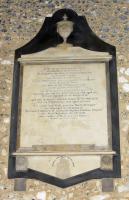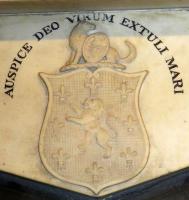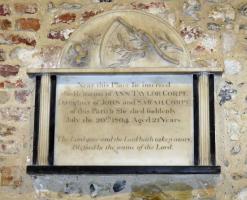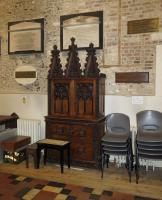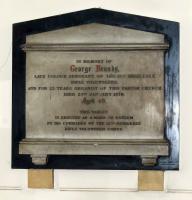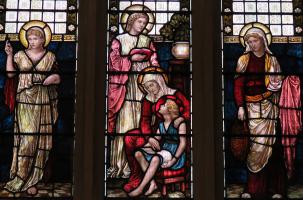High Barnet Church, St John the Baptist - Monuments
High Barnet Church, North London, formerly in Hertfordshire, contains one excellent monument with a statue, one interesting monument with two busts, and a modest number of simpler panels, including signed ones. About half of these plainer panels are in the white-on-black style which became popular at the end of the 18th Century and had its peak through to the 1820s, though the Barnet examples span the Victorian era.
First a few words on the building itself. Today styling itself as Barnet Church, but properly the church of High Barnet (one-time Chipping Barnet), St John the Baptist sits squarely at a junction of the main shopping street. Its most familiar aspect is therefore the East end, with its chequerboard pattern of flint and stone, and the tall fleche or spirelet behind, rather than the stocky tower, also in chequerboard, at the West end. Put up in about 1400, what we see today from outside is largely the work of the Victorian architect William Butterfield, working in 1875, who in the words of a panel inside, ‘enlarged the Church by the addition of the chancel, nave and tower’. Inside there are a variety of 15th century elements and a good exposed ancient wall, but essentially we see a fine Butterfield church rather than a late medieval one.
Barnet Church, William Butterfield exterior.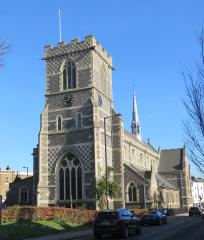
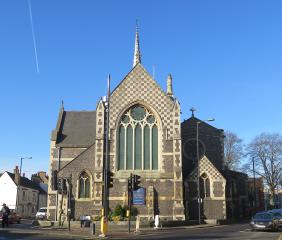
The monuments include a grand figure piece to Thomas Ravenscroft, erected in 1632, and a screen with two busts to the next generation of Ravenscrofts, and a number of simple panels. We start with the Ravenscroft monuments.
Ravenscroft Monuments
Sir Thomas Ravenscroft, d.1630, on a grand scale. His recumbent effigy in pinkish alabaster rests on a tomb chest with six shields of arms of his offspring, each with Latin inscription, this chest itself resting on a broader plinth supporting a double arched canopy on three pillars of dark marble; the canopy itself is massive, heavy, and has both a fretwork top and bears decorations: a central shield of arms, a pair of carved lions at the ends and cherub heads over the arches, and rosettes . Within the enclosure, above and behind the effigy is the inscription, two more shields of arms, and a lovely groined ceiling with central pendants, and more minor decoration. With the coloured alabasters and marbles, gilt and paint, the whole is a splendorous piece indeed. The statue of Thomas Ravenscroft itself, made in highly veined marble or alabaster, is disconcerting to the modern eye by virtue of the strong reddish veins of marble against the creamy white of his face, but this was not unusual for the time and clearly evoked no unease then. Putting that aside, we see a characterful face, with highly modelled cheeks, deep brow, and a straight nose. His hair is curled at the nape, and he has a moustache and combed beard. His hands, in an attitude of praying, have long, sensitive fingers. He wears the clothes of a rich merchant, with great ruff at his neck and smaller ones at the wrists, massive sleeves with decorations to his cloak, many buttons down the front, a high belt hidden by his arms, and then long robes hanging down to his feet, in square-toed shoes. He lies on a tasselled cushion, remnant of kneeler monuments of a previous generation, but rather than staring upwards, looks a little towards the viewer.
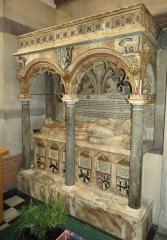
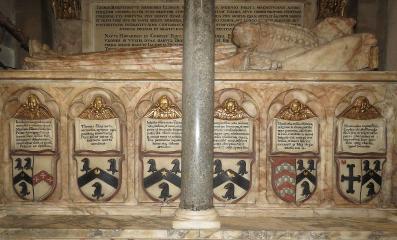
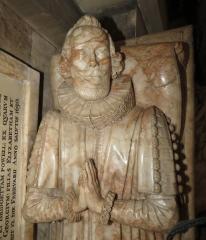
Sir Thomas Ravenscroft, d.1630, in alabaster.
His son and heir, James, who the inscription (as helpfully given in translation from the Latin on the wall) informs us, raised ‘this slight memorial’ in 1632, also notes his father had two wives and six offspring by the first, including himself. Despite James’ assertion, 17th Century memorials do not come more splendid than this.
George Ravenscroft, d.1683, Jacobus [James or Jacob] Ravenscroft, d.1680, Jacobi [James? Daughter of James? – I could not read it well], d.1689, and Joannis [Joanna] Ravenscroft, d.1681. Four dark slatey panels, each with a shield of arms, within a large screen, the two centremost panels raised to round-headed, cusped arches, each enclosing a bust, male and female. The male one, presumably George or James Ravenscroft, shows him staring purposefully a little upwards, with long locks of hair, and Roman senatorial drapery. He is in middle age, but the female bust is a little older, more careworn, also in drapery. Above the pillars dividing the panels are winged cherub heads, and on the outer spandrels [triangular corners above the arches] are small carved lions, standing on crowns. Somehow less than the sum of its parts, artistically speaking.
George Ravenscroft and family, 1680s.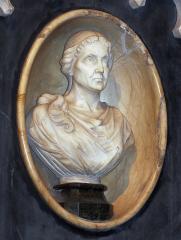
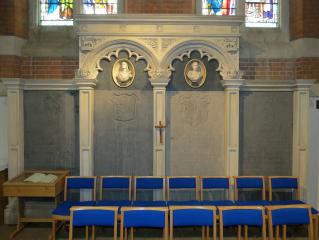
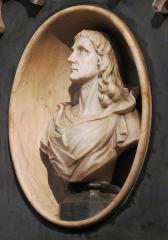
There are two panels to others of the family:
Thomasine Ravenscrofte, d.1611, wife of Thomas Ravenscrofte [Ravenscroft]. With verses, the first of which reads: ‘Whome nature made A lovelye modest mayde // And maryadge made a virtuous loving wife. // Her death hath made a corps & here hath laid // And God a sainct in everlasting life’. The text is in gilt on black, with a frame of salmon-pink marble with panelling, so far so good. The rest is unfortunate restoration: thus the upper shelf, while of a reasonable shape, is made in a strongly veined white marble which is wrong wrong wrong, and the little ornaments above to the sides, which are meant to be flaming funereal urns, have been painted with flame colouring on the handles as well as the flame. Oh dear. On top in the centre, the shield of arms survives unmolested within a characteristic strapwork circlet resting on S-shaped scrolls. But the black backing with its curve at the top is certainly not reflective of whatever was there before, which could have been a backless shelf, or more likely, as there are fragments of an original backing, there was a heavy open pediment with the arms in front of it. The likelihood is that even the pinky marble frame has been cut down from a wider, and likely taller piece. If the monument is ever accidently dropped, the clerics in charge could ask it is not restored like this again.
Jacobus Ravenscroft Ar [Jacob Ravenscroft, Knight], d.1680, with a Latin inscription. Marble panel with frame, shield of arms at the top, carved in low relief, and modern, blocky supports.
Rest of the Monuments
Aside from the Ravenscrofts, and the brasses noted further down, there are a dozen stone panels: two 18th Century, nine 19th Century, and one 20th Century, and a couple of late 20th Century small pieces one of which is wooden. None are exciting artistically, but they show the changeover from coloured to black on white monuments in around 1800, and several of these post-1800 panels are carved as tomb-chest ends: thus a rectangular panel with little feet either attached or cut from the same piece of marble, an upper shelf, and then a shallow lid like a pediment, all on a black panel which might be rectangular or shaped. We take them in chronological order:
Elizabeth Allen, d.1734, ‘who gave an Estate, in this Parish, For the Support and Maintenance of a Schoolmaster, to Teach all the Poor Children in Barnet, Male, and Female, in the English Tongue to Read as far as the Holy Bible and Writing and Arithmetick as far as the Rule of Three...’ Plain panel with thin frame, on two curvy supports. The text in a coy font, looking somewhat restored if not a copy altogether from an older inscription.
Mrs Elizabeth Holmes, d.1776, a minimalist panel with curvy top and bottom. The inscription goes right up to the edges, but fills only half the panel, suggesting an intent to add a husband or other relative later. A little sad.
Elizabeth [Conner] Phillips, d.1798, and her parents, Susanna Conner, d.1768 and John Conner, d.1800, and her husband, William Phillips, d.1828, of Cavenish Square. An early example of the white-on-black panel, in fact an example of the overlap with the use of coloured marbles, for there is a thin frame of greyish-pink marble around the central white panel, itself chosen to have pale inclusions. Thin upper and lower shelves with mouldings, and a nice little pot on top, with carved drapery festoons and beads; the backing panel behind sweeps up in a curve with an idiosyncratic little semicircle on top. At the base, supporting blocks carved with flowers, between which an apron bears the shield of arms carved in low relief, and painted motto.
William White, d.1801, plain panel cut with feet on a mildly carved central support. Humble.
Ann Taylor Corpe, d.1804, panel with thin shelves above and below, and equally parsimonious fluted pilasters to the sides. On top is a well-executed little carving of a scythe cutting a flower, allegory for Miss Cope being cut down as she was in bloom – she died suddenly aged just 21. The two buds may indicate two surviving younger siblings. Signed by Regnart, Cleveland Street, London, who has done many good things elsewhere.
John Corpe, d.1809, Surgeon of Barnet. A neat little oval with a low relief shield of arms, painted, on top.
Cornelius Cope, d.1823. Panel with thin upper shelf with moulding, on which rests a triangle, too tall for a pediment, with a small sunburst, and conventional acroteria (‘ears’) to left and right. On a black backing with little feet.
The Revd. William Marr, d.1825, Curate of the Church. Tall panel with thin upper shelf with mouldings, on which is placed a semicircle, or slightly more than that, containing a carved pot, with chunky acroteria to each side; the effect is uneasy compared to the Classical proportions of a normal pediment. A thick base bearing the shield of arms carved in relief, and supported on two upturned jelly-mould feet. A black shaped surround to the upper part.
Adam Henry G. Block, d.1857, ‘one of the Honourable East India Company’s Deputy Commissioners for the territory of Oude: who perished in the outbreak of the Sepoy mutiny at Sultanpoore’. Cut as a tomb chest end, with thin shelf and upper lid, and on a black backing supported on blocks. Signed by T. Gaffin of Regent Street, the most prolific of all manufacturers of white on black panels.
Samuel Richard Block, d.1864, having become High Sheriff just the year before. Tomb chest end, cut with blocky lid above a thin shelf, and with little feet, on a black backing panel with its own feet.
George Brooks, d.1878, ‘late Colour Sergeant of the 12th Middlesex Rifle Volunteers’ and organist of the Church. Another white-on-black panel, styled as a tomb chest end, with lid, upper shelf, thicker base and feet with mouldings. It is on a shaped black backing panel supported on two blocks. So far, so typical of the last fourscore years. But the spiky black font and the red capitals are borrowed from modern brasses and quite unusual on marble panels. The mason signs as H. Williams, Euston Road.
Arthur Thomas King, d.1922, a bell ringer, white marble panel carved with a frame, with red text.
Percy Cecil Dean, d.1945, Rector, noting the lectern, desk and credence table were given in his memory. Small panel of wood, to match the gifts.
Bernard Butler, d.1980, Rector of the Church. Featureless rectangle of slate, characteristic of a modern age where any ostentation in a memorial is seen as needless ostentation.
Ancient Brass:
Elinor Palmer, d.1558, wife of Edward Taylor, and afterwards wife to John Palmer ‘of Kentishtowne’ [Kentish Town]...’ Just the inscription with no figure. It is significant that this, the oldest surviving piece in the Church, dates from just after the Reformation: information on the Church website says that ‘In 1552... whatever was not required for the new liturgy had to be sold. Statues were damaged or destroyed, carvings smashed, windows broken and valuables stolen...’.
Modern brasses
Charles Sparkes, d.1863, Curate of the Parish. Brass panel with Gothic black text, red dots to mark the spaces between words, a small inscribed decorative vine where there is space, a red cross, and a thick border with religious quote and corner quatrefoils, again with red decoration. On a black backing. A fair example of an early modern brass, revived by the Victorians, and in some earlier examples, as here, retaining a marble backing panel and block supports, while later the panel would hang on its own.
Hannah Stevens, d.1886, one of several window dedications. With a double line border divided into triangles each bearing a frogspawn
William Manning, d.1924, Rector of the Church, brass panel with double inscribed line border, decorated with a Cross with vine leaves between the arms. On a thin wooden backing. The maker was Herbert Wauthier working for F. Osborne and Co, Ltd, London.
Lucy Anne French, d.1926, plain brass panel with inscribed line border.
Also in the Church:
Altar carved by Harry Hems, and pulpit figure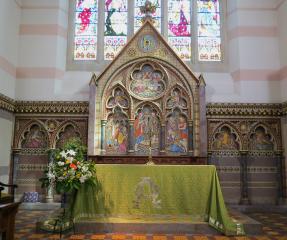
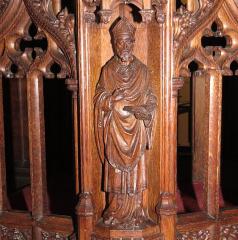
Aside from oddments of the fabric of the Church itself, there is little that is old, principally being the ancient iron-bound chest, perhaps 16th Century, though I pretend no knowledge of such things, and a couple of hatchments on the walls.
There is a panel noting the 1875 reconstruction, with William Butterfield as architect, and G. Miskin as builder. Being Butterfield, we expect polychromy, so we have red and light blue and yellow tiled floors at the altar end, and the altarpiece itself is also polychromatic, a Gothic affair with figures painted on tile, centred on Christ in the manger with his parents and the three wise men, three angels above. The style is a simple illustrative style, aiming for easy viewing from the distance of the nave. In similar style are symbols of the four Evangelists under arches behind. The octagonal sided font with outer pillars of coloured marbles, supporting Gothic arches with balls, also of coloured marbles, also doubtless dates from Butterfield’s exertions.
Then in the late 1880s we have the interestingly carved wooden pulpit, with small figures of missionaries and preachers, which information in the Church informs us are by J.C.Traylen, architect, of Stamford, and executed by Harry Hems and Sons of Exeter, a prolific and leading craftsman of such things. The seating, especially in the Chancel, is of similar date and also much carved.
We should also note the stained glass windows, several with saints, of far better than the usual quality and quite glowing; those indoors are standing on tiled floors, though none in the style of Butterfield.
With many thanks to Barnet Church authorities for permission to show pictures from inside the Church: their website is at www.barnetparishchurch.org.uk. The Church is open: Monday to Friday 9.15am to 5.00pm; Saturday 11.00am to 3.00pm; and Sunday for services.
Nearby: Barnet War Memorial
Aldenham Church to the West // South to La Delivrance statue // South East to Hornsey // East to East Barnet Church and thence to Enfield Church

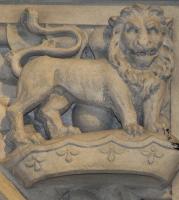
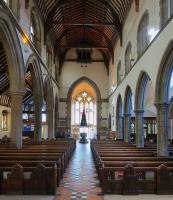
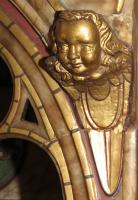
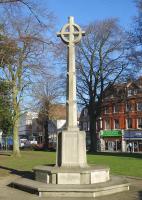
 Thomasine Ravenscrofte, d.1611.
Thomasine Ravenscrofte, d.1611.